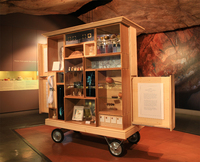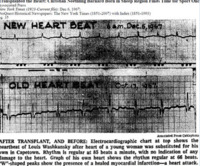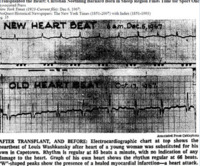Items
Site
The Medicine Chest
keywords is exactly
family
-

A beating heart
"Dear Doctor Barnard I am an 11 year old girl, and I have a problem: I went fishing today; when we came back, my parents cleaned the fish, and after they took out the insides, they found a heart of a fish beating, but the fish was dead and cut up. It was still beating for about 1/2 an hour. Can you explain that? I am very interested in biology, and so is everyone else in my family. Sincerely Yours, Lillian Levy P.S. I know you are a very busy man, but, if you have enough time, please try to answer. THANK YOU! P.P.S. If a doctor says you're dead and they take out your heart but it is still beating, are you dead or alive?" Transcribed letter from the Heart of Cape Town Museum -

Simone
A year after Simone's death from cancer, Cousteau announced that he had been having an affair with a woman, Francine Triplet, for over a decade. He also had two children with her, Diane and Pierre-Yves. -

Strange landscapes
In a short story by the writer Alice Munro titled, 'Walker Brothers Cowboy', a young girl joins her father, a fox farmer turned traveling salesman, on his visits to homes in the countryside where they live. After observing her father nearly getting doused with a chamber pot of urine by an unwelcoming customer, he veers off his usual rounds to visit a woman whom she slowly understands to be his sweetheart from when he was younger. Driving back home, she thinks about the events of the day: "So my father drives and my brother watches the road for rabbits and I feel my father's life flowing back from our car in the last of the afternoon, darkening and turning strange, like a landscape that has an enchantment on it, making it kindly, ordinary and familiar while you are looking at it, but changing it, once your back is turned, into something you will never know, with all kinds of weathers, and distances you cannot imagine. When we get closer to Tuppertown the sky becomes gently overcast, as always, nearly always, on summer evenings by the Lake" (Munro 2010: 23). -

Sudden death of city dentist
Newspaper article about Walter Floyd's death -

Left luggage
St. Pancras Station, London. Suitcases full of holes, handkerchiefs and string sculpture - destroyed by the train pulling out of the station -

Ma
The Japanese have a word, ‘ma’, for this interval which gives shape to the whole – this ‘gap’, ‘opening’, ‘space between’ or ‘time between’. Ma is not something that is created by compositional elements, rather it can be understood as the thing that takes place in the imagination of the human who experiences these elements. A room, for example, is called 'ma', as it refers to the space between the walls. Or a rest in music, which indicates a pause between the notes or sounds (Pilgrim 1986: 255). -

Where their lives took on true weight
In Alice Munro's short story 'Post and Beam', the two protagonists return home from a short vacation: "Up Capilano Road, into their own part of the city and their own corner of the world, where their lives took on true weight and their actions took on consequences. There were the uncompromising wooden walls of their house, showing through the trees" (Munro 2001: 212). -

House
Lokrete with metal armature Grove Road, London, E3 (Destroyed 11 January 1994) -

Kimberlite
A display outside the Cape Town Diamond Museum in the V&A Waterfront -

Kimberlite
Kimberlite specimens, UCT Mantle Room -

Kimberlite
Kimberlite specimen, UCT Mantle Room -

The Diamond Mines of South Africa: Some Account of their Rise and Development.
“In the mines operated by the De Beers Company alone, more than eleven thousand African natives are employed below and above ground, coming from the Transvaal, Basutoland, and Bechuanaland, from districts far north of the Limpopo and the Zambesi, and from the Cape Colony on the east and the south to meet the swarms flocking from Delagoa Bay and countries along the coast of the Indian Ocean, while a few cross the continent from Damaraland and Namaqualand, and the coast washed by the Atlantic. The larger number are roughly classed as Basutos, Shanganes, M'umbanes, and Zulus, but there are many Batlapins from Bechuanaland, Amafengu, and a sprinkling of nearly every other tribe in South Africa” (Williams 1902: 412-413). -

The Diamond Mines of South Africa: Some Account of their Rise and Development.
“The initial impetus for establishing a collection of mantle materials for research purposes in South Africa was provided by Gardner Williams and his son Alpheus Williams in the late 19th and early 20th century. These two American mining engineers shared a great interest in the mining methods and geology of the South African kimberlite-hosted diamond mines they were supervising. Each wrote books on the subject and the two men assembled a collection of scientifically interesting rock samples and minerals from the mines. Subsequent to the death of Alpheus Williams, the Williams family donated this collection to the Geology Department at UCT for teaching and research purposes” (Department of Geological Sciences 2021). -

Burrowing
Extract from 'A Child in Time': "Later, in the sorry months and years, Stephen was to make efforts to re-enter this moment, to burrow his way back through the folds between the events, crawl between the covers, and reverse his decision. But time – not necessarily as it is, for who knows that, but as thought constituted it – monomanically forbids second chances" (McEwan 1987: 14). -

Woman, woman, let go of me
In the chapter he titled, 'When Wendy Grew Up', J.M. Barrie recalls how Wendy tried, for Peter’s sake, not to have growing pains – and how she even felt untrue to him when she got the prize for general knowledge. But the years came and went without bringing the careless boy and Wendy eventually grew up and got married. If you feel sorry for her, don’t. Barrie tells us that Wendy was the kind of girl that liked growing up and that in the end, “ she grew up of her own free will a day quicker than other girls” (1989:182). All grown up with a daughter of her own, Peter visits her again one night while she’s sitting in front of the fire, darning. She hears the crow call and the window blows open as of old, Peter dropping to the floor – looking exactly the same as ever. “He was a little boy, and she was grown up. She huddled by the fire not daring to move, helpless and guilty, a big woman. ‘Hallo, Wendy,’ he said, not noticing any difference, for he was thinking chiefly of himself; and in the dim light her dress might have been the nightgown in which he had seen her first. ‘Hallo, Peter,’ she replied faintly, squeezing herself as small as possible. Something inside her was crying, ‘Woman, woman, let go of me’” (1989: 185 - 186). -

"I have scars on my hands from touching certain people"
"The words of Seymour Glass, eldest sibling of the Glass family – a lesser known creation of J.D. Salinger’s literary world. The story of this family of child geniuses, who appeared on a 1927 radio quiz show called 'It’s a Wise Child', is chronicled in three of his books – mostly centering on the relationship between the two eldest brothers, Buddy and Seymour. Salinger favours Seymour. He was the most brilliant and idiosyncratic of all the children and unfortunately, for the most part, only present as a memory – since he committed suicide, age 31. Buddy reminisces about one specific Seymour moment: His mother urging him to see a psychiatrist and him telling her that he doesn’t need a head doctor – he needs a hand doctor or a dermatologist, whereupon he looks at his hands and tells her he has these scars – these discolourations on them – from touching certain people. Certain heads, certain colours and textures of human hair leave permanent marks on him. When he put his hand on his little sister Franny’s head when she was still in the carriage, it left a mark. Or with her twin brother, Zooey, when he was six or seven, during a spooky movie. He put his hand on Zooey’s head when he went under the seat to avoid watching a scary scene. It left a mark. Other things, too. Charlotte, the girl he was in love with, tried to run away from him once and he grabbed her dress. It left a permanent lemon-yellow mark on the palm of his right-hand (Salinger 1964:59). His hands were filled with these discolourations – these physical manifestations of his emotions. They became a type of medical condition. And he needed to cure it" (Liebenberg 2011: 91 - 93). Salinger recounts the day of Seymour's suicide in a short story he later wrote, called 'A Perfect Day for Bananafish'. -

Iroko
Structurally, 'Chest: a botanical ecology' consisted of 15 modular interlocking cabinets of differing sizes which rested on top of one another, making up the front of the display. These were constructed from two types of wood, the darker iroko wood, and a lighter ash wood – with the iroko originating from the repurposed cabinets used for Curiosity CLXXV in 2004. The Iroko tree is a large hardwood tree from the west coast of tropical Africa, known by the Yoruba as ìrókò, logo or loko. Believed to have supernatural properties, it can live up to 500 years. Yoruba people believe that a spirit inhabits the tree, and anybody who sees the Iroko-man face to face becomes insane and dies. According to the Yoruba, any man who cuts down any Iroko tree causes devastating misfortune on himself and all of his family. In West Africa, the iroko wood is also used to make the djembe drum. If they however, need to cut down the tree, they can make a prayer afterwards to protect themselves. Used for a variety of purposes including boat-building, domestic flooring, furniture and outdoor gates, from the late 1990s, it was also used as part of the txalaparta, a Basque musical instrument constructed of wooden boards, due to its lively sound and classified as an idiophone (a percussion instrument) (Ogumfe 1929: online)). -

Electrocardiograph of first heart transplant
“The ventricular peaks would shoot up as in wild flight, and their intermediate planes would begin to jumble against one another like the sudden crashing of cars on a freight-train. The heart’s beautiful symmetry would then be reduced to an erratic green line of wild jerks until it entered the final isoelectric phase resembling a sawtooth – jagged lines of the heart seeking to rise like a dying bird, fluttering upward, only to fall once again onto its flat plane of death” (Barnard in Young 2002: 79-80). -

Denise Darvall
"During the first heart transplant a shift occurred in the heart of Denise Darvall, the young brain-dead car accident victim whose family had allowed her heart to be given up. In his account of the operation, Barnard writes how her heart’s life fluid returned from the lungs – how many million times had it happened? – but different this time, void of oxygen. How her heart would react, at first, as if meeting only a small inconvenience. Unaware of what was happening, it would simply pump more excitedly – expecting some relief. Yet this would never come, and it would fall back in the first wave of confusion and fatigue. Barnard equates Darvall's heart with a bird trying to take flight" (Liebenberg 2011: 107-108). -

Resonance
Demonstration of sympathetic vibration using the optical (flame) microphone


